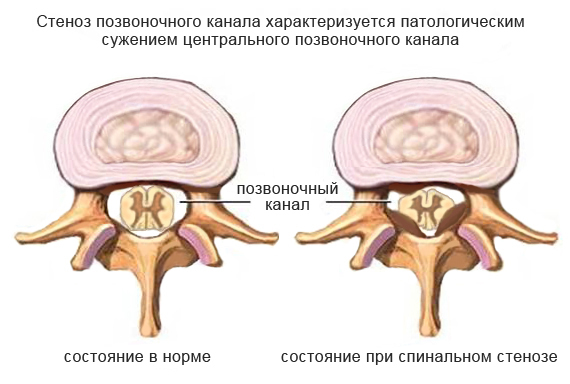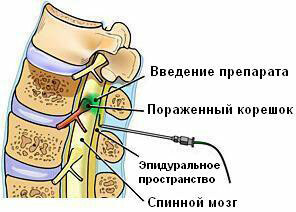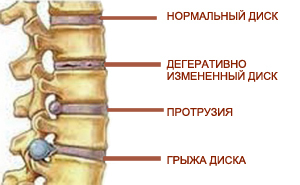 Stenosis of the spinal canal is a pathological degenerative process characterized by a decrease in the diameter of the spinal canal occupied by the spinal cord.
Stenosis of the spinal canal is a pathological degenerative process characterized by a decrease in the diameter of the spinal canal occupied by the spinal cord.
Contents of the article
- Classification of the disease
- What are the main symptoms of the disease?
- Diagnosis
- How is it treated to treat spinal stenosis?
- Conservative treatment
- Surgical treatment
Classification of the disease
The mechanism of spinal stenosis is congenital or acquired by .
Congenital is due to anatomical features and manifests itself in the form:
- shortening of the arch of the vertebrae;
- achondroplasia( increasing the thickness of the arch of the vertebra, reducing the height of his body and shortening the legs);
- cartilage and fibrotic diastematomyelia.
The main causes of acquired( secondary) stenosis are:
- deforming spondylarthrosis, manifested as hypertrophy of the intervertebral joints and the formation of marginal osteophytes;
- ossification of herniated intervertebral discs;
- degenerative-dystrophic spondylolisthesis;
- hyperostosis of rheumatoid nature( Forestier's disease);
- Bechterew's disease;
- hypertrophic proliferation and ossification of the yellow ligament;
- iatrogenic stenosis - subarachnoid spikes and scars formed in the postoperative period.
According to the degree of disease progression:
- narrowing of the canal up to 12 mm - relative stenosis
- narrowing of the canal to 10 mm and less - absolute stenosis
By area of distribution:
- central stenosis
- lateral stenosis
What are the main symptoms of the disease?
Most often, spinal stenosis is seen in the lumbar spine of the .
The disease manifests itself, primarily with back pain , which often radiates to the legs. There is also weakness and a feeling of heaviness in the lower back and legs. Usually these symptoms first appear only after a long load, and after a short rest pass.
Stenosis of the spinal canal at the level of the cervical region is less common, but, due to the fact that in this department the vertebral canal itself is narrow, its narrowing even more immediately manifests itself.
Stenosis and compression of the spinal cord at this level often lead tothe development of myelopathy - a severe neurological pathology, in which, against a background of constantly elevated muscle tone, weakness in the limbs is observed and often the work of pelvic organs is disrupted.

Diagnosis
Diagnosis begins with a careful examination of complaints and clarification of the localization and nature of pain, its relationship to physical activity, and clarification of other symptoms that arise in diseases of the peripheral nervous system: reducing sensitivity, weakness, etc.
Then a physical examination is performed, as a result of which a preliminary diagnosis and clarification of the plan for further examination to clarify the diagnosis is determined.
Most often, with spine stenosis for the purpose of additional examination, roentgenography and magnetic resonance imaging of the spine are performed and sometimes an computed tomography is additionally performed.
 In the case of stenosis, treatment of the intervertebral hernia may be important.
In the case of stenosis, treatment of the intervertebral hernia may be important. You may be interested in what to do with arthrosis of the shoulder joint. Read about this on our website.
How is it customary to treat spinal stenosis?
Conservative treatment of
If the symptoms are moderate, conservative treatment is preferable.
 Such treatment includes, first of all, drug therapy, combined with physiotherapy and massage. Drug treatment consists in the appointment of non-steroidal anti-inflammatory drugs, painkillers and funds that improve blood circulation.
Such treatment includes, first of all, drug therapy, combined with physiotherapy and massage. Drug treatment consists in the appointment of non-steroidal anti-inflammatory drugs, painkillers and funds that improve blood circulation.
In some cases with a persistent pain syndrome epidural is used for the administration of glucocorticoids.
It should be noted, however, that steroid preparations have many side effects, so this method of treatment only when other methods of conservative treatment have proved ineffective.
Surgical treatment of

In cases when the pain becomes unbearable, the pelvic organs are disrupted, the pain in the legs becomes permanent or the weakness in the legs gradually increases, the question arises of the need for surgical intervention.
Given that in most cases the disease is "age", and in elderly patients the operation is not always desirable and possible, it is necessary to carefully weigh all the factors, take into account the general state of health and the possible risk of the operation.
Often, the stenosis of the spinal canal is combined with instability and herniated intervertebral discs, which also affects the choice of surgery.
The main objective of the surgical procedure is spinal cord decompression , therefore the most frequently performed is the decompressive laminectomy , and in some cases the installation of stabilizing systems or interstitial fixation systems.
When a stenosis is combined with a herniated intervertebral disc, microdiscectomy is required, a feature of which is a resection of the bone structures that causes narrowing of the spinal canal than with decompressive laminectomy.



